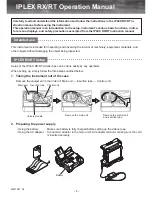
Promega Corporation ·
2800 Woods Hollow Road
·
Madison, WI 53711-5399 USA
·
Toll Free in USA 800-356-9526
·
Phone 608-274-4330
·
Fax 608-277-2516
· www.promega.com
Printed in USA.
Part# TM338
Revised 1/11
Page 19
Symptoms
Possible Causes and Comments
Low or no reading (continued)
Ensure that the orientation of the Minicell
cuvettes is consistent.
Make sure that the Relative Fluorescence Unit
value of the calibration standard is at least 3X
greater than the blank. If the values of the stan-
dard and the blank are too close, the instrument
will register a
Standard<Blank
error message.
Readings outside the linear range
Dilute samples and standards so that the signal
of detection
falls within the linear range of detection.
Fluctuating results
Use the Solid Standard to determine
if the instrument is functioning properly.
Check for spills in the sample compartment. If
liquid is spilled inside the sample compartment,
invert the fluorometer to drain the excess liquid.
Wipe the inside area with a clean soft cloth.
Clean any spills with a damp cloth or a towel
dampened with a mild detergent.
Ensure that sample volume is at least 2ml for a
10 × 10mm cuvette or 50µl for the QuantiFluor™-ST
or 75µl QuantiFluor™-P Fluorometer minicell
cuvette, respectively.
Ensure that the sample cuvette is appropriate.
Methacrylate cuvettes should be used for UV
applications.
Avoid dramatic temperature fluctuations.
Fluorescence is temperature-sensitive. As the
temperature of the sample increases, the
fluorescence decreases. For greatest accuracy,
read the blank, standard and samples at the
same temperature.









































